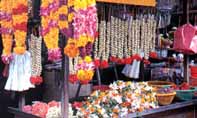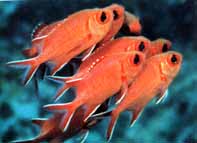|
When
I set out to discover where the greatest variety of underwater
tropical life and most unspoilt tropical seas were to be found in
the world, Malaysia got first mention. But my main reason for
deciding to go there was not for the diving, but to see the way in
which this country with its mystic spiritual culture had at the same
time adapted so thoroughly to the realities of modern life. This
impression is strikingly brought to the attention of arriving
tourists by Kuala Lumpurs Sepang Airport, an architectural wonder
which opened two years ago. When you enter the Far Easts largest
and best appointed airport you feel as if you have entered a
rainforest. The image of a forest within an airport and an airport
within a forest is not merely metaphorical. Within the largely metal
frame and glass building are over eighty tropical trees, gushing
waterfalls,
|

|
and
the calls of exotic birds and animals, instantly erasing the memory
of the long journey you have just made. As well as natural beauty,
the airport boasts every possible modern convenience technology can
provide. There is a five star hotel with 450 rooms, and a large
choice of shops selling everything from local handcrafts to
electronic goods.
On
my way from the airport to my hotel in Kuala Lumpur I decided that
Malaysia was a floral paradise. The edges of the roads were a mass
of luxuriant bougainvillea, nourished to its full splendor by the
sun. Another flower, hibiscus, is the countrys national symbol of
peace and happiness.
|

|
Kuala
Lumpur is the countrys most cosmopolitan and lively city, and at
the same time the regions business and trade center. Most notable
among the many sky scrapers are the Petronas Twin Towers, which
until recently were the tallest buildings in the world. This
architectural masterpiece consisting of two 88-storey sky scrapers
in which up to 50,000 people can work, was designed by the Italian
architect Gesar Pelli. It incorporates some typical features of
Islamic architecture, as appropriate in an Islamic country, and the
two gigantic towers are linked by a bridge on the forty-first and
forty-second storeys. In the two bottom floors is a shopping center
where you can find anything you are looking for, and above this
offices, conference rooms, concert halls, leisure center, banks,
cinemas and residential flats.
|

|
The
worlds third largest building is also in Kuala Lumpur; the 421 m
high Kuala Lumpur Tower, which stands in the heart of the city on a
site 94 m above sea level and stamps its mark on the citys
skyline. This building is Malaysias pride and joy. Constructed
for the countrys telecommunications services there is an 86
meters high antenna made of 115 tons of metal rising from the
summit. At the top of the tower is a revolving restaurant and
panoramic terrace which is the ideal way to round off a busy day
sightseeing since all of Kuala Lumpur is visible from this vantage
point.
|

|
In
1998 Kuala Lumpur hosted the Commonwealth Games, the largest event
ever undertaken by the city, and everywhere are reminders of the
enormous efforts to ensure its success. The light railway recently
built to reduce traffic jams in the city is a cheap and convenient
way to get around. Some of the most famous sights in the city are
the Chinese Quarter, the Central Market, Parliament Building,
National Planetarium, Bird Park and Orchid Gardens where over 800
species of orchid can he seen. Only historic buildings are in short
supply in Kuala Lumpur.
Electronic
equipment and local handcrafts are astonishingly cheap, and in this
respect Kuala Lumpur is a shoppers paradise. The Central Market,
which consists of streets with glass roofs, is one of the oldest
buildings in the city, where you can find all kinds of souvenirs,
antiques, kites, silk dresses and much else. Large modern shopping
centers also abound.
|

|
Visitors
want to see more of Malaysia than Kuala Lumpur, of course, and it is
easy to take one of the numerous flights to the countrys
rainforests and tropical islands where national parks offer
protection to the abundant wildlife. I was enchanted by Sepilok,
Malaysias oldest rainforest, where I stayed in Sepilok Palm
Resort, a complex of bungalows on the shore of a small lake
surrounded by palm trees and orchids. There is also an orangutan
rehabilitation center run by the state in the rainforest. Many young
orangutans, sometimes trained as pickpockets and confiscated from
the homes of local people are brought here to learn to live in their
natural environment and fend for themselves. After two years they
are released into the wild. You come across sonic of these young
orangutans in the forest leaping from the trees and watching you
with curious eyes. They are not entirely harmless, however, and you
will need a guide with you to prevent them snatching your camera.
|

|
Sipadan
Island is one of the world famous sights of Malaysia. Surrounded by
an underwater wonderland which so impressed Jacque Cousteau, the
island is of volcanic origin, rising from the sea bed 600 m below.
Its beaches are a breeding ground for turtles which each year swim
hundreds of kilometers back to their birthplace to lay their own
eggs. At night, in the company of a guide and on the condition of
remaining silent, you may go down to the shore and watch the
enormous turtles lumbering up from the sea to dig nests in the sand
and lay their eggs, over one hundred at a time. These eggs are later
gathered and reburied in a safer place. Eighty days later the eggs
hatch and the young turtles scurry to the sea.
While
diving around Sipadan it is a common sight to see these protected
animals, along with shoals of bonito, barracuda, hump-headed parrot
fish and sharks. Even using a snorkel the colorful coral reefs and
tropical fish of these waters are a delightful sight. Another
favorite place for observing underwater life is the nearby island of
Kapalai, where you can stay in bungalows raised on stilts over the
sea at Kapalai Resort, which opened
last
|

|
year.
Awakening to the sound of fish splashing in the water beneath you
and spending the day exploring beneath the sea make for an
unforgettable holiday. The use of dynamite by local fishermen has
destroyed the local coral reefs, so large fish species are no longer
to be found in this area, but there is still a colorful diversity of
underwater life to be seen, such as small sea slugs of all colors,
spectre pipefish, jaw fish, mandarin fish, scavenger shrimps, squid,
and nautilus. Malaysia is a holiday destination combining all the
luxuries of the modern world with spectacular natural beauty, so if
you are making holiday plans do not hesitate to put Kuala Lumpur at
the top of your list.
|